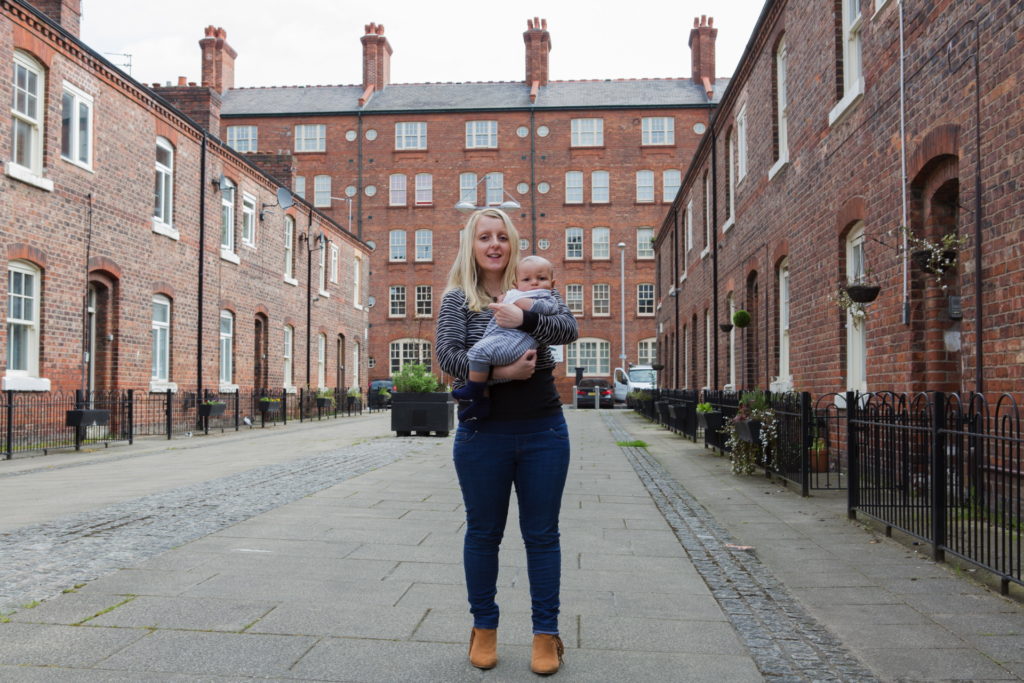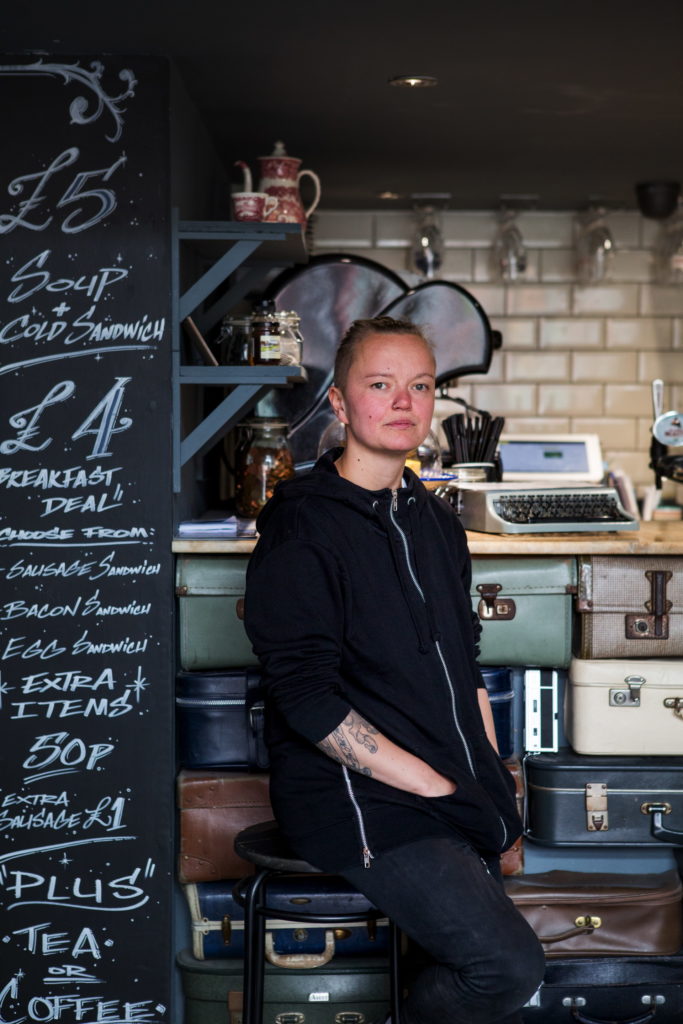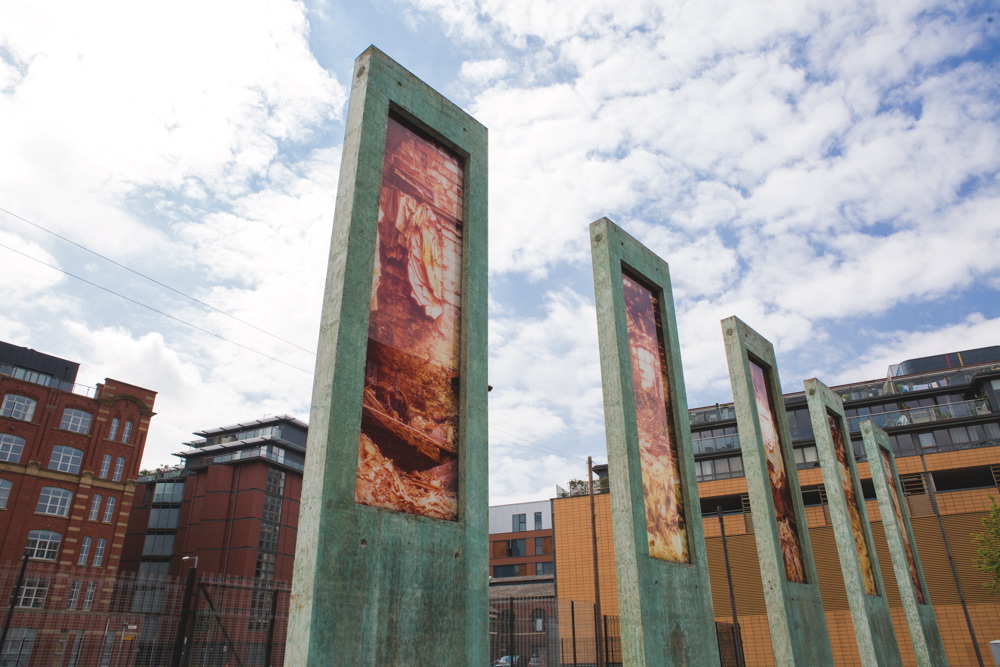The second revolution
In our series on former urban wastelands now on the up, Richard Smirke is in Manchester’s Ancoats, the birthplace of the industrial revolution
It’s a hot May afternoon and Ancoats’ Cutting Room Square is teeming with life. Residents criss-cross the central piazza overlooked by the impressive red brick façade of Hallé St Peter’s and five giant monolithic art sculptures. Students from the nearby Manchester Creative Studio bask in the midday sunshine on timber blocks resembling cotton bales. Builders toil in one of the area’s new commercial developments and office workers pile into the adjacent café or neighbourhood pizzeria for a well-earned lunchtime snack or aperitif.
Blink and you could almost be in a bustling town square in Italy, Spain or France, as opposed to a long neglected part of East Manchester once synonymous with crime and unlit streets best avoided at night. The contrast between now and just 10 years ago, when decades of post-industrial decline had left large parts of Ancoats a deserted wasteland with an unsavoury reputation, is hard to believe.
“Before we came here people warned us: ‘Don’t move there. It’s really rough. Full of druggies and you’re going to have loads of problems’,” recalls Laura Gandini, who’s lived in the area for seven years. “We’ve had no issues at all and the area has only improved since then.”
The regeneration of Ancoats has been a long time coming. Just one kilometre east of Manchester city centre the district was the world’s first industrial suburb with its remarkable landscape of Georgian, Victorian and Edwardian mills, housing and warehouses testament to its pivotal role in the industrial revolution, beginning in the late 18th century with construction of the first cotton mills.
The opening of the Rochdale Canal, along Ancoats’ southern border, in 1804 accelerated the area’s development, bringing with it a rapidly expanding population of mill hands, weavers and spinners. By the mid-eighteen hundreds, more than 50,000 people lived in Ancoats – making it bigger than towns such as Bury and Blackburn. Living conditions were inhumanly poor. In 1845, Friedrich Engels described working men’s dwellings in Manchester as being so wretched that only a “degenerate race, robbed of all humanity, degraded, reduced morally and physically to bestiality, could feel comfortable and at home”, with Ancoats particularly full of “ruinous houses”.
By the mid-eighteen hundreds, more than 50,000 people lived in Ancoats
Although thousands of immigrant workers from across Europe – predominantly Ireland and Italy – continued to settle in the area, giving it a multicultural flavour, it wasn’t to last and the slump in the cotton industry in the 1930s precipitated the area’s decline.
As the mills began closing the population decreased and the mass clearance of terraced housing in the 1960s relocated families around Manchester. Within a decade, the once thriving district was decimated, its mills left to rot, its schools and public buildings closed. Ancoats Hospital (better known as Ancoats Dispensary) closed in 1989, with only its outer shell still standing today.
“I blame the council for a lot of the things that happened in Ancoats. It was left to its own devices and became run down. They should have taken more of an interest and done more to keep the community together,” says Anthony Rea, who was born and raised in the area. Rea’s family is one of the many Italian dynasties to set up in the ice cream industry and help make an enclave of Ancoats around St Peter’s Church become known as Little Italy.
He has vivid memories of growing up with “ice cream vans on every corner” and the cobbled streets full of traders. “In the late 1960s a lot of the characters were still around. It was very colourful, especially at Christmas – family get-togethers with all the food, accordions, singing and dancing. Funerals and weddings were another big occasion when the whole community would come together.”
Rea’s family moved out of Ancoats in the 1970s. By the end of the decade, its population had dwindled to less than 500 people, most of them in Victoria Square – a five-storey grade II listed block of municipal tenements dating back to 1894.

Recognising the historical importance of the area, in 1989 Manchester City Council designated 50 acres of Ancoats a conservation area, with 13 of its buildings listed, including Murrays’ Mill – once one of the largest cotton spinning buildings in the world. A regeneration scheme helped save landmark properties and lay the foundations for what, after many years of private and public investment and several false starts, is now once again a neighbourhood on the up.
“The change may seem recent and swift, but the first components of the area’s regeneration were started on-site around the turn of the century,” explains Bernard Priest, deputy leader of Manchester City Council. “Heritage buildings within a conservation area, many protected by listing designation, can prove a difficult prospect for developers, but the neighbourhood that is growing there is special because the city’s history lives on repurposed and reborn.”
Having learned lessons from other regeneration projects in the North West, Priest says the council has encouraged smaller businesses to set up in Ancoats, rather than corporates “in the hope of creating a strong community of people and families. They’re helping Ancoats to become a destination in its own right, set apart from the rest of the city centre.”
One of those businesses is Rudy’s Neapolitan pizzeria, which opened in Cutting Room Square last year and has proved a hit, with queues regularly snaking out of the door. Owners Jim Morgan and Kate Wilson were attracted to Ancoats because of its heritage and architecture, not to mention the important lower cost of setting up a business in an area yet to reach its potential.
“It was the only place in the city that we could afford,” explains Morgan, who “could not be happier” with the location. “People always talk about Ancoats being a ghostland but that’s not true anymore. There’s a huge amount of people here working in offices or living in flats, but until recently there hasn’t been that ground floor culture of restaurants, shops, cafés and public spaces. People were just living here and walking into the city or going to the Northern Quarter. That’s no longer the case.”
“I know my neighbours, call them by their names and have a chat.”
Another thriving business in Ancoats’ central square is Cutting Room café and bar, opened by Sophie Jarvis and Adam Regan last autumn. On moving to the area around five years ago, Jarvis says they were “confused as to why there were no bars, restaurants or anything fun happening. We fell in love with the area, saw the potential for growth and what a beautiful suburb it could be, so decided to take the plunge.”
Buoyed by their success the pair plan to open a fine dining restaurant with its own microbrewery, Goose Fat and Wild Garlic, in Ancoats later this year. It’s one of several new food and drink openings planned, which will join a swelling business sector that includes Armitage Construction, digital marketing agency Rocketfish, wig makers Wigs Up North and dozens of independent companies and artists based at Awol Studios in Hope Mill. There’s Sankeys nightclub, based at Beehive Mill since the mid-nineties, and the recently opened Hope Mill Theatre. St Peter’s Church is the second home to Manchester’s Hallé orchestra.
“We’ve been in London for seven years, where it feels like everything has been done. So to come here and feel like we’re actually part of something new is great,” says Joseph Houston, who opened the 150-seater Hope Mill Theatre with his partner William Whelton earlier this year. “It’s very easy for investors to come in and say: ‘I’m going to build flats here.’ But if we can build a creative community in then we’ll hopefully be here for a long time.”
The transformation is having a positive impact on residents. “When we first moved here there was lots of construction going on. Then with the recession it all just stopped. The cranes disappeared, buildings were left half done and it all went a bit bleak. Now it feels like people are starting to believe in the area again,” says Laura Gandini, who lives in Anita Street (shortened from Sanitary Street when indoor plumbing became less of a major selling point) with her sister Claudia and six-month old baby Matteo.
“It’s taken a long time and I thought it was going to develop a lot quicker than it has, but everything that has been built here has been done really well,” adds Claudia, who says that Ancoats retains a tight-knit community feel. “Everybody helps everybody out on our street. You don’t feel like you’re on your own and I can’t imagine that many people living in the city centre can say that. People are really proud of living here. We are.”
“I love it here,” agrees teaching assistant Rebecca McGuinness, who has lived in Ancoats for 12 years. “There’s no problems, very little in the way of crime. I know my neighbours, call them by their names, have a chat. It’s convenient for town, but not in it – just on the edge. It’s great.”
That’s not to say that Ancoats isn’t without problems. There’s still an abundance of derelict buildings, while neighbouring Miles Platting, Collyhurst and Newton Heath have yet to reap the benefits of inner city regeneration and contain some of the highest levels of child poverty in the North West.
New Islington, the £250 million pound redevelopment of Ancoats’ notorious Cardroom estate, has only been a partial success, with the recession halting many of the building schemes that were meant to provide over 1,700 homes, including a small provision of social housing.

The first residents moved in in 2005, but 10 years on large parts of New Islington remain a brownfield site wrought with maintenance problems and anti-social behaviour. Gradually, things are improving however. The Michelin-starred restaurant that developer Urban Splash promised is yet to appear, but there is a new health centre, marina and wildlife zone – Cotton Field Park. New premises for the outstanding-rated New Islington Free School are under construction.
Last year, the area received a further boost with the announcement that Manchester Life Development Company – a joint venture between the City Council and Abu Dhabi United Group (owners of Manchester City football team) – was investing £1 billion in building 900 new homes in Ancoats and New Islington. Development work at Murrays’ Mill began this month with 124 new apartments due to be completed.
“Successful urban regeneration must be focused on fostering lively and interesting streets, open spaces, canals, squares, and making the most of local heritage,” Manchester Life executive chairman Marty Edelman tells Big Issue North.
Rea welcomes the commitment to preserving its industrial history, but warns that redevelopment will only be successful if investment is maintained. “There’s no point in regenerating places to then let them go back to how they were 20 years ago, like we’ve seen in the past,” he warns. But he is optimistic.
“It’s down to the new people moving into Ancoats to create the memories and that colourfulness and community spirit that not only the Italians brought to the area, but also the indigenous English families, the many Irish families, the Jewish people who had businesses there. They all contributed in their own way to the soul of Ancoats and I hope that lives on in the new generation of people that live there.”
All photos: Rebecca Lupton. Next month we visit Holbeck in Leeds and Sheffield’s Kelham Island. And if you missed it… here’s our feature on Liverpool’s Baltic Triangle.

Leave a reply
Your email address will not be published.